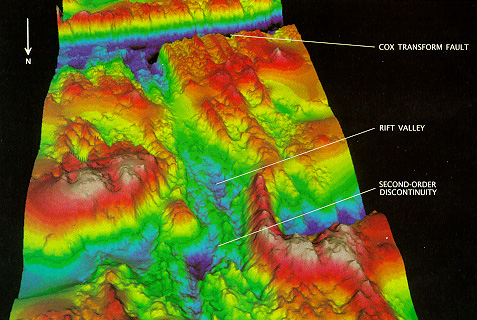
A section of the mid-Atlantic Ridge where the African and South American Plates are created. A rift valley over a mile (2 km) deep marks the axis of the ridge. Depths range from 1900 (pink) to 4200 meters (dark blue). Image used with permission of Ken Macdonald.
Divergent (or spreading centers) plate boundaries are characterized by features called mid-ocean ridges. Combined, the ridges are nearly 46,000 miles (74,000 km) long. The ridges are home to Earth's highest mountains, deepest canyons, and longest escarpments. The shape of the mid-ocean ridge and the style and rate of volcanism is controlled by the rate the plates move apart.

Growth of tectonic plates at mid-ocean ridges. This photo shows a ropy lava flow erupted in April 1991, on the floor of the axial summit collapse trough of the East Pacific Rise near 9 degrees 50.6'N. Note dead tubeworms. Photography courtesy of Woods Hole Oceanographic Institution and members of the Adventure dive (Principle Investigators: D. Fornari, R. Haymon, K. Von Damm, M. Perfit, M. Lilley, and R. Lutz).
New oceanic plates are created at mid-ocean ridges. About 2.4 cubic miles (10 cubic km) of new oceanic crust is added each year (not all of this magma is erupted by volcanoes). This is about 100 times the volume of lava erupted by Kilauea each year.
Mid-ocean ridges are divided into these groups based on their spreading rates:
Slow: 1-5 cm/yr total opening rate
Medium: 5-10 cm/yr total opening rate
Fast: 10-20 cm/yr total opening rate